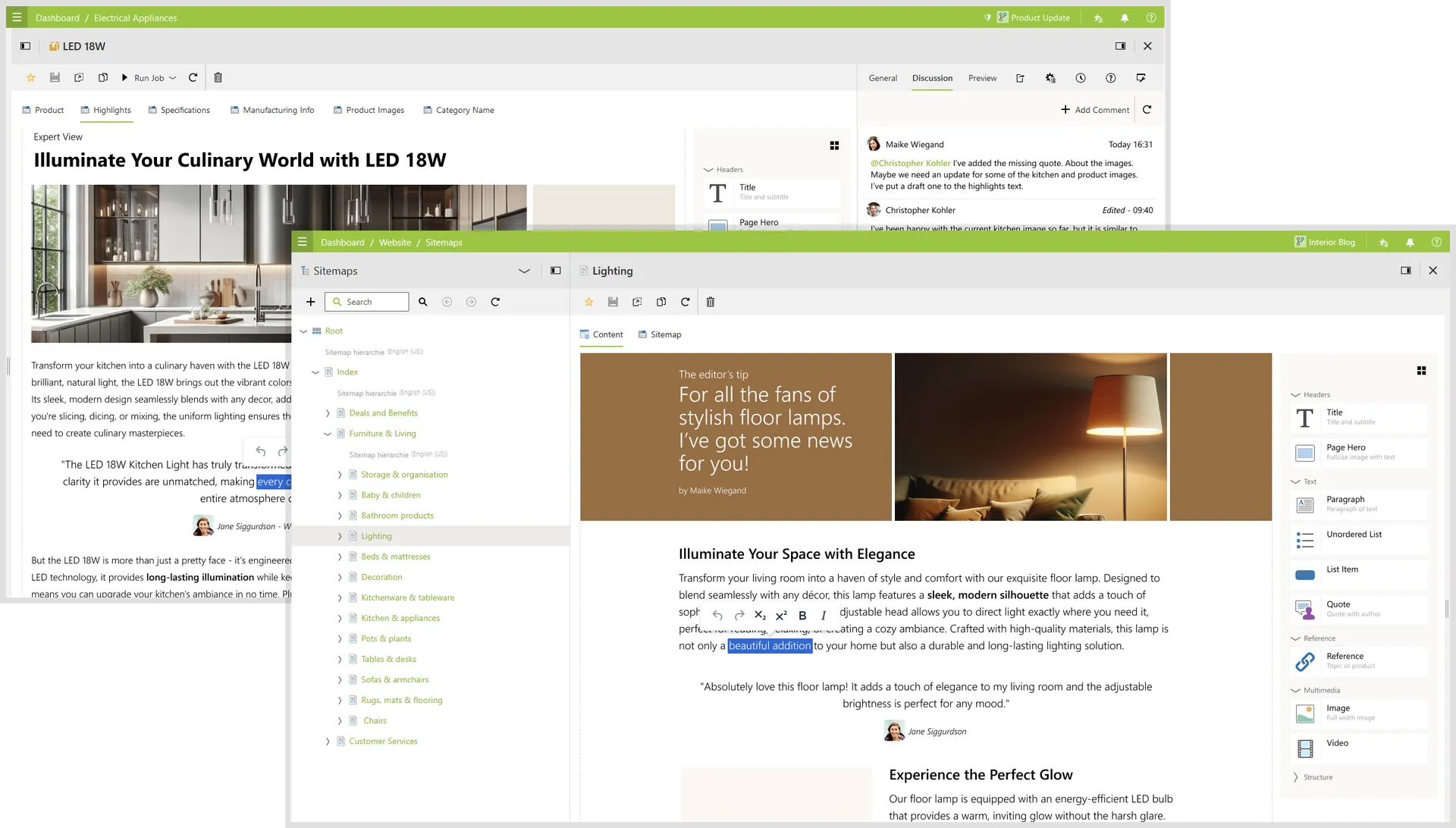Connected Customer Experience: Why It Matters
Connected Customer Experiences (CX) have become a strategic success factor for marketing leaders. In a connected world, customers expect consistent, personalized, and brand-aligned interactions—across all channels and in real time. This article outlines how companies can use integrated systems (CMS, PIM, MAM) to strategically enhance CX, strengthen brand perception, reduce time-to-market, and deepen customer loyalty.
What Is Connected Customer Experience?
A connected customer experience unifies every customer interaction across channels by linking data, technology, and touchpoints. It ensures seamless transitions between platforms like email, chat, and in-store visits, enabling personalized engagement based on real-time behavior and preferences.
Connected customer experiences are based on the idea of delivering seamless and consistent interactions across all channels. This requires the integration of systems such as Content Management Systems (CMS), Product Information Management (PIM), and Media Asset Management (MAM), and any other system that an organization uses to deliver content and data to customers. These systems jointly manage content, product data, and digital assets to ensure that customers experience the same messaging and brand quality across all platforms—building credibility and trust.
At the core it is the ability to personalize interactions in real time based on data. Understanding customer behavior and preferences through unified data allows businesses to tailor content and offers without compromising brand consistency. As Volker Römisch, Head of Consultant at Noxum, puts it: "A connected customer experience is not just about linking systems—it's about aligning every message, offer, and channel with the customer’s actual needs."

Customer Expectations in the Omnichannel Era
From the customer’s perspective, connectedness means seamless navigation, quick access to information, and personal interaction—regardless of the device or channel. Today’s customers expect smooth processes, immediate accessibility, and a clear personal benefit. Technology is expected to stay in the background; the experience itself must be simple, efficient, and empathetic. Flexibility, real-time responsiveness, cross-channel communication, and relevant content are especially valued.
Key Components of a Connected Customer Experience
Achieving Channel Consistency with Omnichannel Integration
Omnichannel integration involves unifying various communication channels to provide a consistent customer experience. Whether a customer interacts via email, chat, phone, or in-store, the experience should be seamless. This requires integrating systems and data across all channels to maintain context and continuity.
Building a 360° Customer View Through Data Unification
Centralizing customer data from different sources allows businesses to gain a comprehensive view of each customer. This unified data enables personalized interactions and informed decision-making.
For instance, if a customer browses products online and later visits a store, sales associates can access their browsing history to provide tailored recommendations.
Enhancing Customer Engagement with Real-Time Personalization
Personalization goes beyond addressing customers by name; it involves delivering relevant content, offers, and support based on individual preferences and behaviors. By leveraging unified data, businesses can create experiences that resonate with customers, increasing engagement and satisfaction.
Benefits of Connected Customer Experience Solutions
Reinforcing Brand Identity with Unified Content and Messaging
A strong, consistent brand presence is essential for building trust and recognition. Integrated systems like CMS, PIM, and MAM create a centralized framework to manage content, product data, and media assets—ensuring aligned messaging, visuals, and information at every customer touchpoint.
This centralized setup improves data quality and enables real-time updates, so product information and branding elements are always current and accurate. It also empowers businesses to deliver targeted, personalized content quickly—leading to cohesive, relevant, and trustworthy customer experiences across all channels.
Streamlining Campaign Execution Across Teams and Channels
Solutions like NovaDB Headless CMS and PIM help streamline process chains and adapt them flexibly to different target channels.
Integrated systems enable smooth operational execution of marketing campaigns. The focus is on process optimization and efficient collaboration: tasks can be centrally coordinated, responsibilities clearly assigned, and time-sensitive workflows automated. The CMS manages editorial content, the PIM ensures accurate product data, and the MAM supplies the appropriate media. This end-to-end process logic saves time and reduces friction.
Teams benefit from centralized work environments that support resource sharing, content review, and faster approval processes. This boosts execution capabilities—especially in markets where speed and agility are critical.
Reducing Time-to-Campaign
Connected experiences accelerate campaign preparation by automating the flow of information across systems—eliminating manual handovers and bottlenecks. Marketing teams gain real-time access to relevant data, enabling quick adjustments and faster decision-making.
Automating repetitive tasks saves resources and minimizes errors, allowing more focus on strategy and creativity. Especially in industries with complex products, connected systems offer the flexibility needed to respond quickly to customer feedback and market changes.
Enabling Fast Execution
Connected systems support the fast execution of strategies by collecting and analyzing data in real time. This enables marketing teams to quickly understand customer behavior and needs—providing the foundation for targeted, effective campaigns.
Improved communication between departments helps teams align and make adjustments more quickly. In complex industries, this means precise targeting and quick response to market dynamics. AI technologies enhance this with predictive analytics, automated recommendations, and intelligent decision support.
Efficient Coordination and Approval
Well-integrated systems simplify campaign coordination and approval by providing centralized platforms for feedback, alignment, and sign-off. Stakeholders can easily review and approve content—avoiding delays.
These systems also support scalability, consistent data maintenance, and automated processes—reducing effort and increasing productivity. Full transparency over all campaign components also simplifies regulatory compliance—strengthening brand trust.
Challenges in Implementing a Connected Customer Experience & How To Overcome Those
Delivering connected customer experiences involves overcoming various challenges. Disparate data sources must be consolidated to create a holistic customer view. Powerful data management systems are needed to ensure accuracy and consistency.
At scale, personalization can be significantly enhanced using AI-driven analytics—especially in conjunction with CRM systems that consolidate customer data and enable behavior-based segmentation. While AI is not strictly necessary, it speeds up processes, increases targeting precision, and supports automated recommendations. Alternatively, rule-based or manual segmentation methods can be used, though these are more time-consuming and less scalable. Additional support comes from content platforms, marketing automation tools, and Customer Data Platforms (CDPs). This technology stack requires investment in systems and know-how. In parallel, adapting to new tools, enabling cross-functional collaboration, and fostering a customer-centric culture are key success factors.
Another crucial aspect is handling personal data responsibly. Customers expect transparency and privacy—as well as clear benefits in exchange, such as more relevant content, faster service, or exclusive offers. Trust is built where data is handled sensitively and transparently—this is a cornerstone of sustainable customer experiences.
Integrating Legacy Systems
Many organizations operate with outdated systems that don't easily integrate with modern technologies. Bridging these systems requires careful planning, investment, and sometimes significant overhauls to ensure seamless data flow and communication.
Ensuring Data Privacy and Security
Handling vast amounts of customer data necessitates stringent privacy and security measures. Compliance with regulations like GDPR and maintaining customer trust are paramount when collecting and utilizing personal information.
Aligning Cross-Departmental Goals
Creating a connected customer experience involves collaboration across various departments—marketing, sales, customer service, IT, and more. Aligning goals and ensuring effective communication among these teams can be challenging but is essential for a unified strategy.
Strategies for Connected Customer Experience Implementation
Mapping the Customer Journey to Identify Friction Points
Mapping the customer journey helps identify all touchpoints and potential pain points. Understanding the customer's perspective allows businesses to design experiences that meet their needs and expectations at every stage.
Technology Investments That Enable Omnichannel Success
Adopting technologies that facilitate integration, data analysis, and automation is crucial. Tools like Customer Relationship Management (CRM) systems, data analytics platforms, and AI-powered chatbots can enhance the customer experience when implemented effectively.
Empowering Teams to Deliver Consistent Experiences
Employees play a vital role in delivering a connected customer experience. Providing training and resources empowers them to utilize tools effectively and deliver consistent, personalized service.
Continuous Feedback and Improvement
Regularly collecting and analyzing customer feedback helps identify areas for improvement. Implementing changes based on this feedback demonstrates a commitment to customer satisfaction and fosters trust.
Key Capabilities in CMS, PIM, and MAM for Scalable CX
NovaDB Headless PIM and Headless CMS offer particularly flexible options for organizing content and data independently of the frontend—ideal for complex, dynamic omnichannel scenarios.
To unleash their full potential, integrated systems must meet certain requirements. A modern CMS must support flexible content models, multilingual content, omnichannel publishing, and intuitive editorial workflows. A powerful PIM should be able to consolidate product data from various sources, enrich it to high quality, and distribute it across channels automatically. For a MAM system, intuitive asset management, version control, rights management, and integration with creative tools are essential.
Shared requirements across all systems include open APIs, scalability, usability, and seamless integration into existing IT environments. Headless architectures allow businesses to manage content and data independently of the website or app design—giving them greater flexibility to deliver content across different platforms. This allows flexible delivery across a variety of touchpoints—such as websites, mobile apps, or IoT devices. Headless systems provide a flexible foundation, making it easier to reuse content across websites, apps, and other platforms—ensuring adaptability as technology evolves.
Through the strategic use of integrated systems, companies gain measurable value: enabling coherent communication, faster execution, and more tailored customer interactions. Those who embrace both technological and content-level integration position themselves for the future. Ultimately, it is the combination of technical excellence and true customer focus that fosters long-term loyalty and sustainable market success.

Conclusion
In many projects, it has become evident: headless architectures like those offered by NovaDB not only provide technological flexibility but also enable significantly faster time-to-market and higher personalization.
Connected Customer Experiences are a strategic success factor that goes far beyond system integration. Companies that approach CX holistically—with customer perspective, technological flexibility, data-driven insights, and human empathy—create differentiation and build trust. The key lies in the intelligent combination of system architecture, content governance, and customer understanding. Those who bring these elements together lay the foundation for long-term brand loyalty and meaningful customer experiences across the entire journey.
